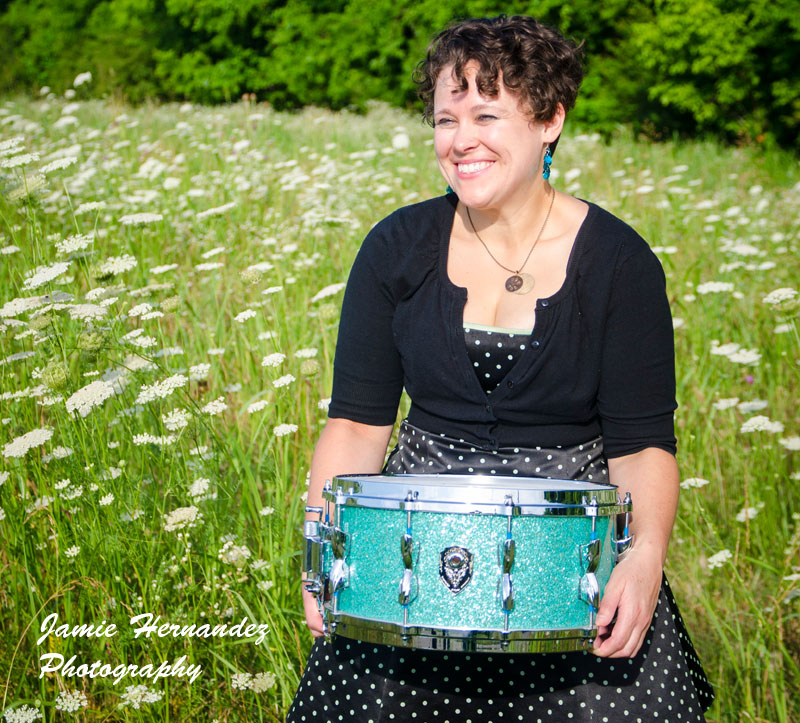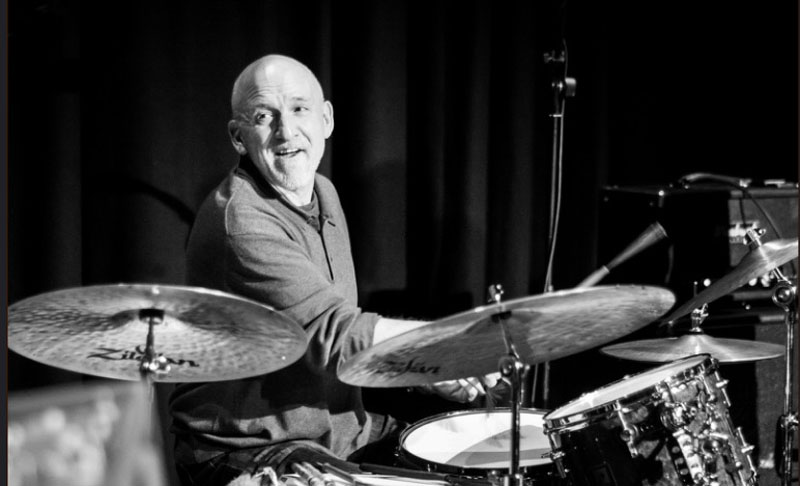Shelly Manne (1920-1984) was an internationally recognized jazz drummer most associated with the style known as ‘West Coast Jazz’. Shelly was so versatile that he was asked to play on virtually hundreds of Hollywood movies and television soundtracks. While Shelly’s extensive discography is amazing, the list of musicians he has played or recorded with is truly mind-boggling. So Modern Drummer asked five distinguished drummers to share their ideas and opinions concerning the following quote attributed to Shelly Manne:
"The ride beat is the easiest and the most difficult thing a drummer will ever play."
1. Jane Boxall
The ride beat is equally fascinating and frustrating, to me, because it relies on nuance and balancing various extremes. It's so well known, and so often heard, yet drummers want and need to make this pattern their own. With only a three-note rhythmic loop it is a short and limited pattern. Within these three strokes we have many choices to make about rhythmic hierarchy and accents. What is most important is how the three strokes relate to each other within each loop and between looping repetitions. It's a simple repetitive pattern but it needs to be fluent and to flow smoothly.
The ride beat needs to be prominent in the sonic texture but never sounding forced. My impression is that one of the main differences between rock/pop and jazz styles is in which pieces of the drum kit drive the groove. In rock and pop the groove is built from the ground up, with the kick and snare providing a powerful backbeat. In jazz the whole groove is often suspended, hanging off the ride and the hi-hats. While these elements of the kit are not perhaps as articulate or piercing as the kick and snare, they still have to be present and heard by the other musicians and the audience. As with everything involving the ride beat, it's a sonic balancing act.
The other balancing act, to my ears, is between straight and swung time. All drummers seem to have a slightly different approach to the swing of the ride beat, making it sharper or looser, more widely spaced or relatively crushed together. I've noticed that this pattern has a tendency to swing widely at slower tempi, and to gradually "straighten out" as the speed increases. In between there's wonderful nuance, and a need to negotiate the space between straight and swung time.
(Photo Credit : Jamie Hernandez)
Jane Boxall is an award winning drummer/percussionist of the highest caliber. Jane is one of a very limited number of marimba artists worldwide to have developed an 8-mallet technique. Her album, Zero to Eight Mallets, continues to be increasingly popular with percussionists and non-percussionists alike since its release in 2012. She has also shared the stage with Vernon Reid, Danny Seraphine, Les DeMerle, and many others.
In 2015 and beyond, Jane will be touring internationally as a concert artist, session drummer, and clinician. She is a contributing writer for Tom Tom Magazine, and an in-demand studio and live percussionist. Jane was also a regularly featured performer at the annual Chicago Drum Show.
Born in England and raised in Scotland, Jane completed her BA and MA in Music at the University of York (UK), and her Doctorate in Percussion Performance at the University of Illinois.
http://janeboxall.com/drums.htmlhttps://www.facebook.com/janeboxallhitsthings
2. Les DeMerle
The ride beat is a drummer’s signature. It is very easy to teach, but the player has to really study jazz and listen to all the great players. This really makes it come alive and swing. Shelly was right on the money, and his ride patterns are some of the best. ‘Keep Swingin’.
Les Demerle has been on the cutting edge of jazz drumming since first playing with Lionel Hampton at the age of 16. A few years later, he was asked to replace Buddy Rich in the Harry James Band. Les always believed he was the luckiest drummer on the planet getting that gig. Imagine replacing the greatest drummer of all time? Les DeMerle had the chops to do it while spending 12 years with Harry James. He also fronted a number of his own bands including ‘Les DeMerle’s Transfusion’…His instructional books, Jazz-Rock Fusion Volumes One and Two remain quite popular. Les is presently on tour with the Les DeMerle Orchestra featuring his wife, vocalist, Bonnie Eisele - DeMerle.
https://www.facebook.com/les.demerle.9https://www.facebook.com/pages/Les-DeMerle-Fan-Page/273936424968
3. ROB THE DRUMMER (Robert L. Gottfried)
On the subject of Shelly being "The Mann" Shelly was great! My comments…
I can’t really assume to know where Shelly was “coming from” when he made this statement, under what context he said it, what followed or preceded it in conversation, or even what kind of a day he was having where he waxed philosophical and technical at the same time! But it alludes to a deeper understanding of one of the most primary obstacles a young drummer may have to hurdle, and so bears attention for us all, the young and the young-at-heart!
The ride beat assumes you can establish a flow; it takes that for granted, which is not terribly easy for some, unfortunately. “Feel” is a mysterious process and involves going over a specific task 10,000 times (the newest figures through testing with bicyclists) in order for it to be ‘muscle memory’. You have to do that many times so you don’t have to ‘think’ when you’re doing it, just like martial arts. If you have to think what move you have to make, you’re already dead! So in order to be truly at peace with your own insides, your own heartbeat,your emotions, i.e. in order to actually Be In The Moment, you have to get to the point that you’re not thinking! You did the work on yourself…now you shine…and Flow! You’re not thinking of where the flow is…You Are It ! Sorry - a little ‘heavy’, but true I believe.
Technically, the pause when you’re coming up on ‘1’ to let the cymbal sing and ring, followed by the 2 buildup strokes to the next pause seems to be the hardest part to negotiate for the beginner. They don’t leave it long enough to let it sing enough, or too long so it doesn’t flow enough…awkward…jerky. To my mind, it should be nothing less than hypnotic; an endless flow. And even as I’m writing this, it’s only my interpretation and has little to do with “right” or “wrong”, just personal. I direct my students to bring the “1” up high, kicked with the little finger and let the stick do the work through its natural bounce as my first teacher, Joe Porcaro, taught me. ”The Bounce” is one of his most famous approaches - just follow the natural bounce off the cymbal with your hand; bounce up! Don’t muscle it!
You don’t usually get asked a question like what this statement of Shelly’s brings up. I imagine he was also thinking of the push-pull effect, that is, your pushing forward with the flow. Tony Williams comes to mind; the blistering aggression but at the same time, space, literally and figuratively!! The way it can fill a room or kick a 25-piece big band is to let it speak but keep the heat on. It’s a very sensitive affair. That’s why it takes years to perfect. The great thing about really focusing on one idea like this is that it forces you to dive into depth on what you really think and feel about something you just quickly blew through, perhaps, when you first started because it was “required”,needed. But now we’re taking the time to investigate. Enjoyable!
Robert L. Gottfried is an internationally recognized drummer and educator. His concerts enlighten people through his unique approach to drumming which transcends all language and cultural barriers. Every year, Rob’s anti- substance abuse, and anti-bullying programs reach out to thousands of children across the nation. Gottfried had appeared as ‘Rob The Drummer’ on Sesame Street for many years. He has also been featured on Entertainment Tonight, Nickelodeon, MTV, and numerous other programs. Rob plays with Jeff Pevar and Friends, and teaches over 40 private drum students from all over New England.
http://www.robthedrummer.comhttps://www.facebook.com/ROBTHEDRUMMER
4. Dave Mattacks
That comment of Shelly's is seriously right. Whether it's straight 8th notes, the "swing" ride pattern ("splang-a-lang") or even straight quarter notes (with eighth, triplets or even an "in-the-cracks" feel underneath), just about every drummer thinks they can play it.
The truly difficult part is to make it feel good. That does not necessarily equate to playing them 'machine-like' and tight, though playing them reasonably even definitely helps at all tempos and levels. The real key and challenge, in my humble opinion is to make the music feel good, and that is a lifetime's quest.
With international notoriety, Dave Mattacks has played on over two hundred albums - including five with Sir Paul McCartney. Since the 1960’s, his long résumé reads like a who’s who of the UK and American music scenes. Revered and respected around the world; Dave represents a first-rate example of the totally consummate professional…Creative and focused at all times…His primary objective is always about the music. He has played with Fairport Convention, Jethro Tull, Cat Stevens, George Harrison, Elton John, Jimmy Page, XTC…The list goes on and on. Dave also has a full schedule of playing, recording, and producing. He also teaches and presents numerous master classes, and clinics around the globe.
http://www.dmattacks.co.uk/main_fr.htmhttps://www.facebook.com/dave.mattacks
5. Adam Nussbaum
Simple does not necessarily mean ‘easy’. Playing the ride beat musically has eluded numerous drummers over the years. It’s most imperative to focus your attention on how to PLAY the cymbal, and not just hit it. The ride at any tempo is supposed to flow. Practicing that motion slowly, while feeling the space between the notes is of primary importance. The place where the swing is....
Additionally, listening to a wide variety of jazz & good music in general will open up endless possibilities for those serious about getting it right. It takes time…
Adam Nussbaum has played, and recorded with some of the finest musicians on the planet. His extensive biography, and discography, include stints with - The Brecker Brothers, John Abercrombie, James Moody, John Scofield, and Dave Liebman, just to name a few. Adam also teaches at such notable institutions as Berklee College of Music, The State University of New York, The New School for Social Research, and New York University. Adam Nussbaum is very serious about music education…Presenting clinics and master classes at numerous conservatories around the world.
http://www.adamnussbaum.nethttps://www.facebook.com/adamnuttree






